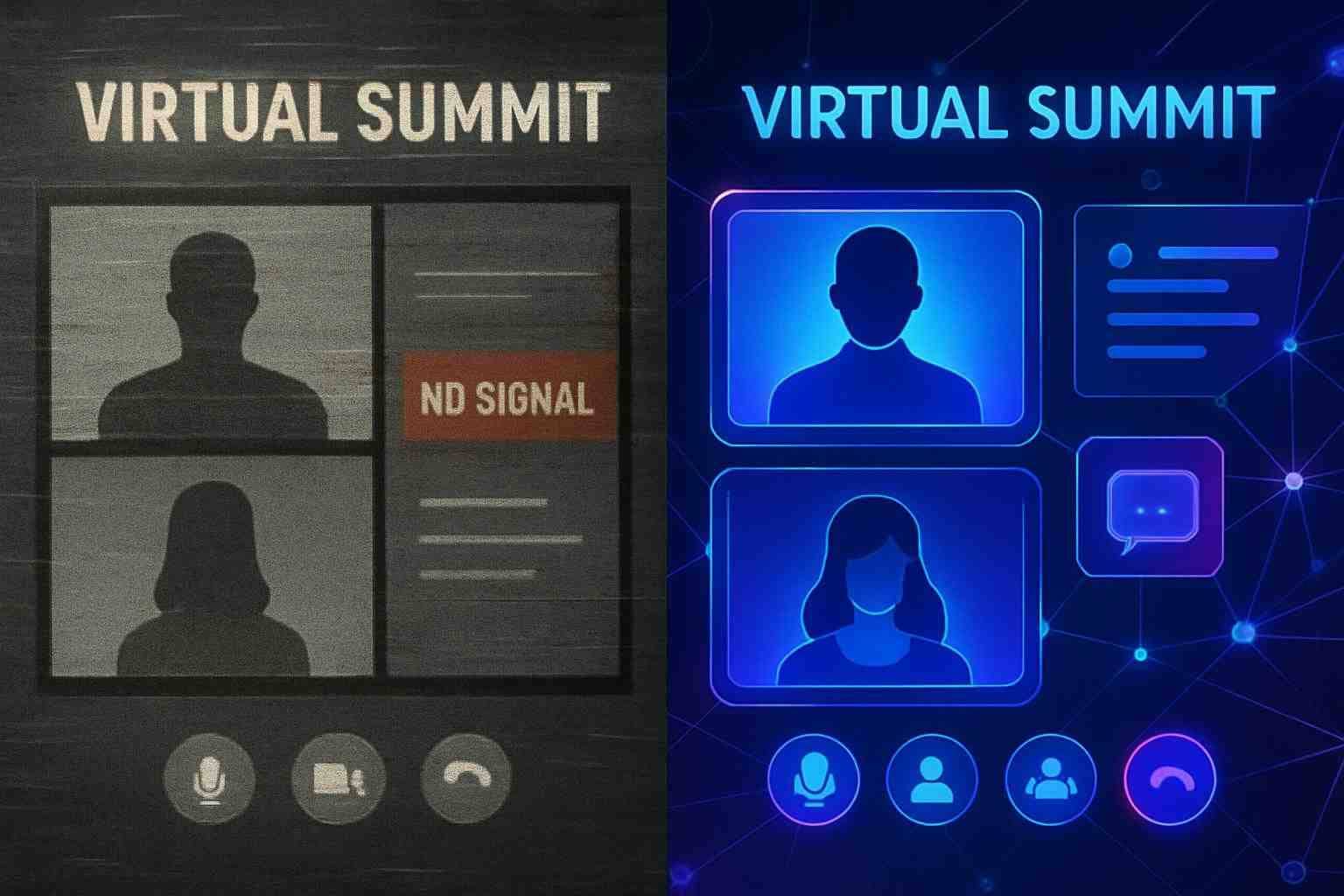
Why Your Current Virtual Summit Platform Is Hurting Your Attendee Experience (and How to Solve It)
The digital event landscape has evolved dramatically over the past few years, and virtual summits have emerged as a vital tool for engaging audiences across geographies. However, not all virtual summit platforms are created equal. Many platforms that once served their purpose can become outdated or inadequate as attendee expectations grow and technology advances. In this article, we’ll explore the common pitfalls of current virtual summit platforms, understand how these shortcomings negatively impact the attendee experience, and offer practical solutions to help you elevate your virtual events.
Understanding the Shortcomings of Your Virtual Summit Platform
It’s easy to assume that any platform designed for virtual events should be able to handle the myriad responsibilities required during a live summit. Unfortunately, the reality is often quite different. Many current platforms struggle with a variety of issues that can hinder user engagement and diminish overall event satisfaction.
Some of the most common issues include:
- Outdated User Interfaces: A clunky, non-intuitive interface can make it hard for attendees to navigate sessions, view content, or connect with speakers and other participants.
- Technical Glitches: Frequent glitches, such as lagging video streams or delayed audio, disrupt the flow of presentations and cause frustration for both presenters and participants.
- Limited Interactivity: Many platforms offer only basic chat functions and fail to provide robust engagement tools like live polls, breakout rooms, or integrated Q&A sessions.
- Compatibility Issues: Platforms that don’t function well across various devices—desktops, tablets, and smartphones—can alienate a segment of your audience who expect seamless access regardless of their device.
- Insufficient Analytics: Without comprehensive, real-time feedback, organizers often struggle to understand attendee behavior and engagement, making it harder to improve future events.
These shortcomings can significantly detract from the overall experience, leaving your audience frustrated and less likely to return for future events.
How Platform Limitations Impact Attendee Experience
The attendee experience is the cornerstone of any successful event. When participants feel lost in a maze of technical issues or encounter limited interaction opportunities, their enthusiasm wanes. A poor virtual summit platform can create a domino effect of negative experiences. Here’s how:
- Disrupted Engagement: When a platform is slow or unresponsive, live interactions such as Q&A sessions or polls suffer, reducing the excitement of real-time collaboration. Attendees might feel like passive viewers rather than active participants.
- Frustration and Drop-off: Technical glitches, confusing navigation, and compatibility issues can lead to frustration. In turn, this increases the risk of attendees abandoning the session before it even begins.
- Negative Word of Mouth: An underwhelming experience doesn’t end when the event concludes. Participants are likely to share their negative experiences on social media or via word of mouth, potentially deterring future attendees.
- Missed Opportunities: Without advanced engagement tools, you miss the chance to capture valuable data and real-time feedback. This data is crucial for tailoring your content and improving subsequent events.
Understanding these impacts is crucial. By identifying the specific limitations of your current virtual summit platforms, you can begin to implement solutions that not only improve technical reliability but also enhance the overall experience for your audience.
The Importance of a Seamless User Experience in Virtual Summits
In today’s fast-paced digital world, attendees have little patience for platforms that hinder their experience. They expect seamless navigation, interactive content, and the ability to connect with peers in real-time. A state-of-the-art user experience is not just a luxury—it’s a necessity for building trust and encouraging active participation.
Consider what your attendees expect:
- Intuitive Navigation: Participants should be able to easily access sessions, interact with content, and locate resources with minimal effort.
- Engagement and Interaction: Features like live polls, breakout sessions, and real-time Q&A not only drive participation but also foster a sense of community among attendees.
- Personalization: An effective platform should allow for customization so that each attendee can tailor the event experience to their interests, whether that’s choosing different tracks or engaging with specific speakers.
Ensuring a smooth and cohesive experience not only boosts engagement rates but also enhances your reputation as a forward-thinking, user-friendly event organizer. Investing in modern virtual summit platforms can lead to higher attendee satisfaction and, ultimately, more successful events.
Practical Solutions to Enhance Your Virtual Summit Experience
Rather than accepting subpar performance from your current platform, consider the following actionable strategies to enhance your virtual summit experience:
-
Conduct an In-Depth Assessment:
Start by collecting feedback from previous attendees. Surveys, post-event questionnaires, and even informal interviews can reveal valuable insights about which areas cause the most friction. -
Map Out the User Journey:
Before your next event, create a detailed flowchart of the attendee experience—from registration to session participation and post-event follow-up. Identify potential bottlenecks that could be improved. -
Invest in Robust Features:
Look for features that are essential for engagement:- Live polls and Q&A sessions
- Interactive networking spaces or virtual breakout rooms
- Seamless integration with other tools (like CRM or email marketing platforms)
- Comprehensive analytics for real-time data tracking
-
Test Across Multiple Devices:
Ensure that the platform performs consistently on desktops, tablets, and smartphones. A responsive, device-agnostic design is critical for reaching a broad audience. -
Enhance Technical Support:
A dedicated technical support team that can assist in real-time during the event can mitigate issues before they escalate.
By taking these steps, you can transform the way attendees interact with your event, paving the way for greater engagement and satisfaction.
Key Features to Look for in a New Virtual Summit Platform
If your current solution is failing to meet your needs, upgrading to a modern virtual summit platform might be the best solution. When evaluating new options, look for these key features:
- User-Friendly Interface: The platform should be intuitive and easy to navigate for both seasoned and new users.
- Robust Interactivity: Features such as real-time Q&A, live polls, breakout rooms, and networking hubs are essential to keep attendees engaged.
- Customization Options: Branding, personalized agendas, and tailored content are critical for creating a unique event experience.
- Scalability: Whether you’re hosting a small niche summit or a large conference, the platform should easily handle varying audience sizes without compromising performance.
- High-Level Security: Protecting user data and ensuring secure transactions should be a top priority.
- Comprehensive Analytics: Detailed reports and real-time metrics can provide insights that help optimize your next event.
By leveraging these features, you can create an environment where attendees feel valued, engaged, and eager to return—all while making it easier for you to manage and improve future events.
Transitioning Smoothly to a More Effective Platform
Switching from an outdated system to a more modern one might seem daunting, but with careful planning, the transition can be smooth and beneficial. Here’s a quick checklist to help guide your transition:
- Data Migration: Ensure that all existing attendee and event data can be securely transferred to your new platform without loss.
- Training and Onboarding: Allocate time for thorough training sessions with your team. Familiarize them with the new interface and features to avoid any learning curve issues during the actual event.
- Technical Support: Work with a platform that offers robust customer support—preferably 24/7—especially during the transition phase.
- Trial Runs: Conduct pilot sessions or mock events to test the platform’s performance and gather feedback, enabling you to fine-tune the system before the official launch.
By taking a structured approach to the migration process, you’ll minimize disruptions while ensuring that both your team and your attendees are comfortable with the new environment.
Assessing the Impact of a Modern Virtual Summit Platform
The benefits of upgrading to a state-of-the-art virtual summit platform are tangible. When you invest in a more robust system, you are likely to see improvements in several key areas:
- Increased Engagement: A modern platform supports interactive sessions that keep attendees involved and stimulate discussion.
- Enhanced Reliability: Reduced technical glitches mean that sessions run smoothly, allowing participants to fully immerse themselves in the content.
- Better Insights: With comprehensive analytics, you can gather valuable feedback that helps shape future events and tailor your content strategy more effectively.
- Improved Networking: Tools that facilitate seamless interaction allow attendees to connect with peers, exchange ideas, and form lasting professional relationships.
Consider the success of a well-executed virtual summit where the platform functioned as a bridge rather than a barrier. Attendees appreciated the ease of registration, the interactivity during sessions, and the clear, responsive support when needed. These small improvements can collectively lead to higher satisfaction rates, better audience retention, and a positive reputation that could translate into increased revenue for future events.
Real-World Success: A Case Study in Platform Transformation
Imagine a company that hosted regular virtual summits using a platform that slowly became an obstacle rather than a tool. Attendees began to notice recurring issues—difficulty navigating the interface, intermittent streaming problems, and limited interactive features. As attendance dropped and feedback turned negative, the organizers faced a critical choice.
After extensive research and consideration, they decided to transition to a modern virtual summit platform equipped with advanced features like real-time analytics, customizable sessions, and robust technical support. The results were transformative:
- Attendee engagement skyrocketed as the platform enabled interactive features such as live polls, Q&A sessions, and virtual networking lounges.
- The real-time analytics allowed organizers to instantly address concerns and tweak the event experience to suit audience needs.
- A seamless transition plan, including pilot runs and comprehensive staff training, ensured that the switch caused minimal disruption.
The event’s success not only revitalized interest in future summits but also attracted sponsorships and partnerships that had previously been out of reach. This case study underscores just how vital a capable virtual summit platform can be.
Conclusion
In today’s competitive digital landscape, the platform you use for your virtual summits can make or break the overall attendee experience. Outdated systems that hinder engagement, cause technical headaches, and offer limited interaction not only frustrate your audience but also tarnish your brand’s reputation. By recognizing these issues and proactively seeking solutions, you can transform your events into dynamic, interactive experiences that keep your audience coming back.
Remember, it’s not just about hosting an event—it’s about creating an experience where every attendee feels connected, engaged, and valued. Upgrading to a modern virtual summit platform with robust capabilities is the first step in ensuring that your events run smoothly and successfully, meeting the high expectations of today’s digital audience.
Ready to take your virtual events to the next level? If you’re eager to provide a seamless, engaging experience for your attendees while enjoying the benefits of advanced tools and reliable support, explore the powerful webinar hosting platform JetWebinar. Sign up for a free trial today and experience firsthand how JetWebinar can revolutionize your virtual summits, boost engagement, and help your events stand out in a crowded digital landscape.
Elevate your event strategy with a platform that truly meets your needs—your audience deserves nothing less.


